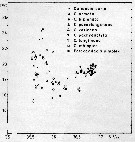|
|
 |
Fiche d'espèce de Copépode |
|
|
Calanoida ( Ordre ) |
|
|
|
Diaptomoidea ( Superfamille ) |
|
|
|
Candaciidae ( Famille ) |
|
|
|
Candacia ( Genre ) |
|
|
| |
Candacia paenelongimana Fleminger & Bowman, 1956 (F,M) | |
| | | | | | | Ref.: | | | Fleminger & Bowman, 1956 (p.332, figs.F,M); Grice, 1963 (p.178, fig.F); Vervoort, 1965 (p.173, Rem.); Owre & Foyo, 1967 (p.94, figs.F,M); Bradford-Grieve & al., 1999 (p.885, 956, figs.F,M); Vives & Shmeleva, 2007 (p.458, figs.F,M, Rem.) |  issued from : A. Fleminger & T.E. Bowman in Proc. U.S. Natn. Mus. 1956, 106, No 3370. [p.333, Fig.1]. Female: a, habitus (dorsal); b, cephalon (lateral); c, urosome (lateral, right side); d, same (dorsal); e, Mx2; f, Mxp; g, urosome (ventral); h, proximal portion of A1; i, P5; j, ramus of P5 (distal half); k, 3rd exopodal segment of P4; l, 3rd exopodal segment of P3; m, 3rd exopodal segment of P2; n, Md (gnathobase). Nota: Cephalothorax-urosome length ratio appears to be of no value in distinguishing between individuals of this species and C. longimana. Genital segment tends to be longer and caudal rami shorter in Paenelongimana as compared to C. longimana (Giesbrecht, 1892, Taf.39, figs.4, 6).
|
 issued from : A. Fleminger & T.E. Bowman in Proc. U.S. Natn. Mus. 1956, 106, No 3370. [p.335, Fig.2, a-g]. Male: a, habitus (dorsal); b, 5th thoracic segment and 1st urosomal segment (lateral, right side); c, posterior corner of right 5th thoracic segment (dorsal); d, process of 1st urosomal segment (dorsal); e, P5; f, right A1 (segments 15-19; dorsal view); g, right caudal ramus (dorsal). Nota: The male can easily be confused with C. longimana, but can be distinguished by the shape of the process on the right side of the 5th thoracic segment (especially from the side).In longimana this process is somewhat variable, but relatively shorter and heavier than in paenelongimana.
|
 Issued from : J.M. Bradford-Grieve, E.L. Markhaseva, C.E.F. Rocha & B. Abiahy in South Atlantic Zooplankton, edit. D. Boltovskoy. 1999, Vol. 2, Copepoda; [p.1065, Fig. 7.372: Candacia paenelongimana ]. Ur = urosome; B = basis; rGns = genital segment.
| | | | | Ref. compl.: | | | Park, 1970 (p.478); Roe, 1972 (p.277, tabl.1, tabl.2); 1972 c (p.1039); Vives, 1982 (p.294); Brenning, 1985 a (p.28, Table 2); 1987 (p.29, spatial distribution, T-S diagram, Rem.); Lozano Soldevilla & al., 1988 (p.60); Suarez & al., 1990 (tab.2); Suarez & Gasca, 1991 (tab.2); Suarez, 1992 (App.1); Suarez-Morales & Gasca, 1998 a (p108); Medellin-Mora & Navas S., 2010 (p.265, Tab. 2) | | | | NZ: | 2 | | |
|
Carte de distribution de Candacia paenelongimana par zones géographiques
|
| | |  Carte de 1996 Carte de 1996 | |
 issued from : U. Brenning in Wiss. Z. Wilhelm-Pieck-Univ. Rostock - 36. Jahrgang 1987. Mat.-nat. wiss. Reihe, 2. [p.27, Fig.1]. issued from : U. Brenning in Wiss. Z. Wilhelm-Pieck-Univ. Rostock - 36. Jahrgang 1987. Mat.-nat. wiss. Reihe, 2. [p.27, Fig.1].
Spatial distribution for Candacia curta, C. armata, C. bipinnata, C. paenelongimana, C. varicans (as varians), C. pachydactyla, C. longimana, C. ethiopica, Paracandacia simplex ( = C. simplex) from 8° S - 26° N; 16°- 20° W, for different expeditions (V1: Dec. 1972- Jan. 1973; V2: Feb/Mar. 1973; VI: May 1974; IV: Jun./Jul. 1972). |
 issued from : U. Brenning in Wiss. Z. Wilhelm-Pieck-Univ. Rostock - 36. Jahrgang 1987. Mat.-nat. wiss. Reihe, 2. [p.28, Fig.2]. issued from : U. Brenning in Wiss. Z. Wilhelm-Pieck-Univ. Rostock - 36. Jahrgang 1987. Mat.-nat. wiss. Reihe, 2. [p.28, Fig.2].
T-S Diagram for Candacia curta, C. armata, C. bipinnata, C. paenelongimana, C. varicans, C. pachydactyla, C. longimana, C. ethiopica, Paracandacia simplex ( = C. simplex) from 8° S - 26° N; 16°- 20° W. |
| | | | Loc: | | | ? G. of Guinea, Morocco-Mauritania, Canary Is., off Amazon, Barbada Is., Caribbean Sea, Caribbean Colombia, Bahamas, G. of Mexico, Cuba, Florida | | | | N: | 17 (Atlant. N: 15; Atlant. S: 2) | | | | Lg.: | | | (16) F: 2,87-2,65; (199) F: 3,12-2,74; M: 2,96-2,66; (346) F: 2,92-2,54; M: 2,49; (1110) F: 2,8-3,04; M: 2,96; {F: 2,54-3,12; M: 2,49-2,96}
The mean female size is 2.835 mm (n := 8; SD = 0.1939), and the lean male size is 2.768 mm (n = 4; SD : 0.2329). The size ratio (male : female) is about 0.97. | | | | Rem.: | épi-mésopélagique
Voir aussi les remarques en anglais | | | Dernière mise à jour : 26/01/2016 | |
|
|
 Toute utilisation de ce site pour une publication sera mentionnée avec la référence suivante : Toute utilisation de ce site pour une publication sera mentionnée avec la référence suivante :
Razouls C., Desreumaux N., Kouwenberg J. et de Bovée F., 2005-2025. - Biodiversité des Copépodes planctoniques marins (morphologie, répartition géographique et données biologiques). Sorbonne Université, CNRS. Disponible sur http://copepodes.obs-banyuls.fr [Accédé le 05 janvier 2026] © copyright 2005-2025 Sorbonne Université, CNRS
|
|
 |
 |








